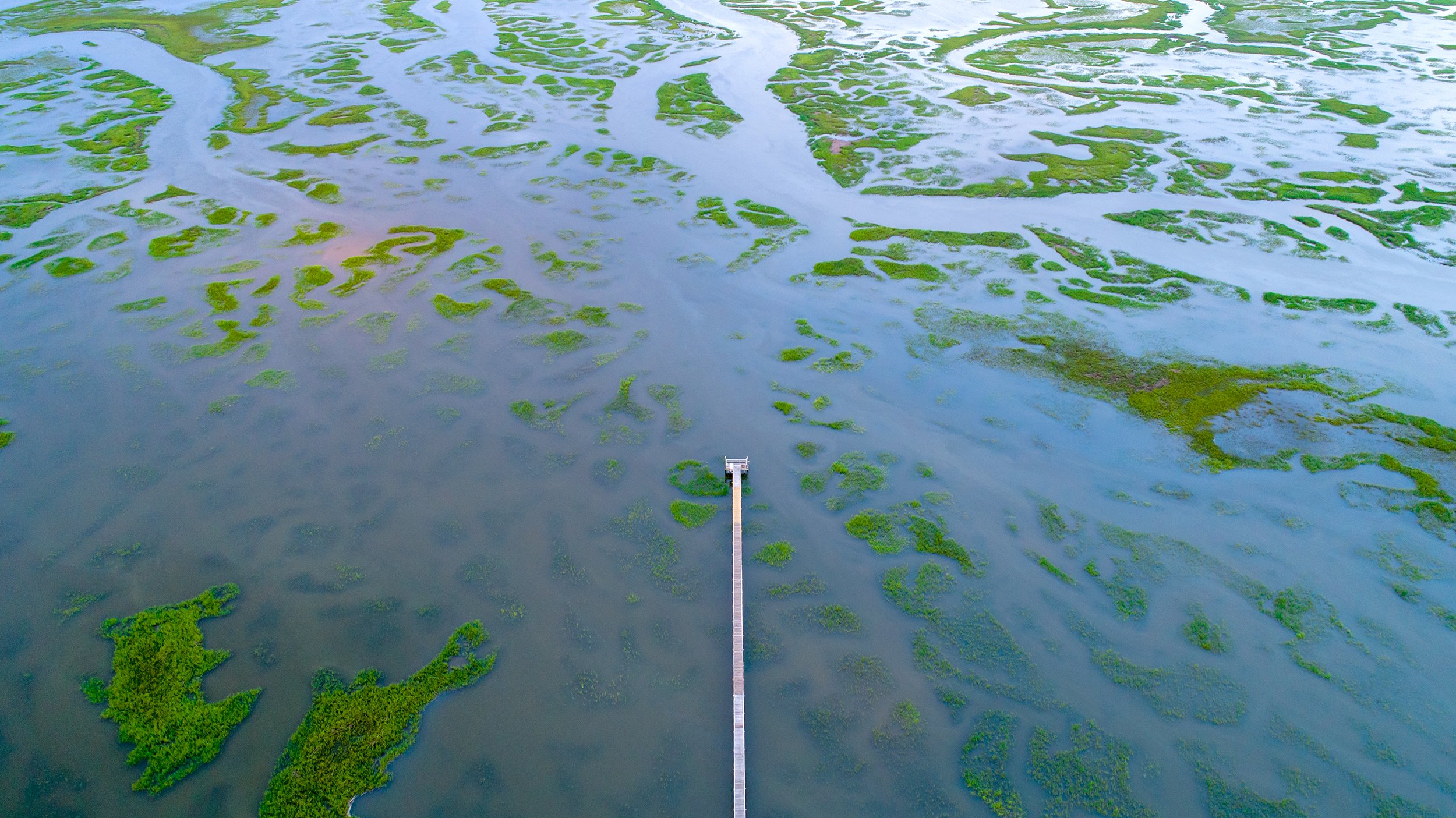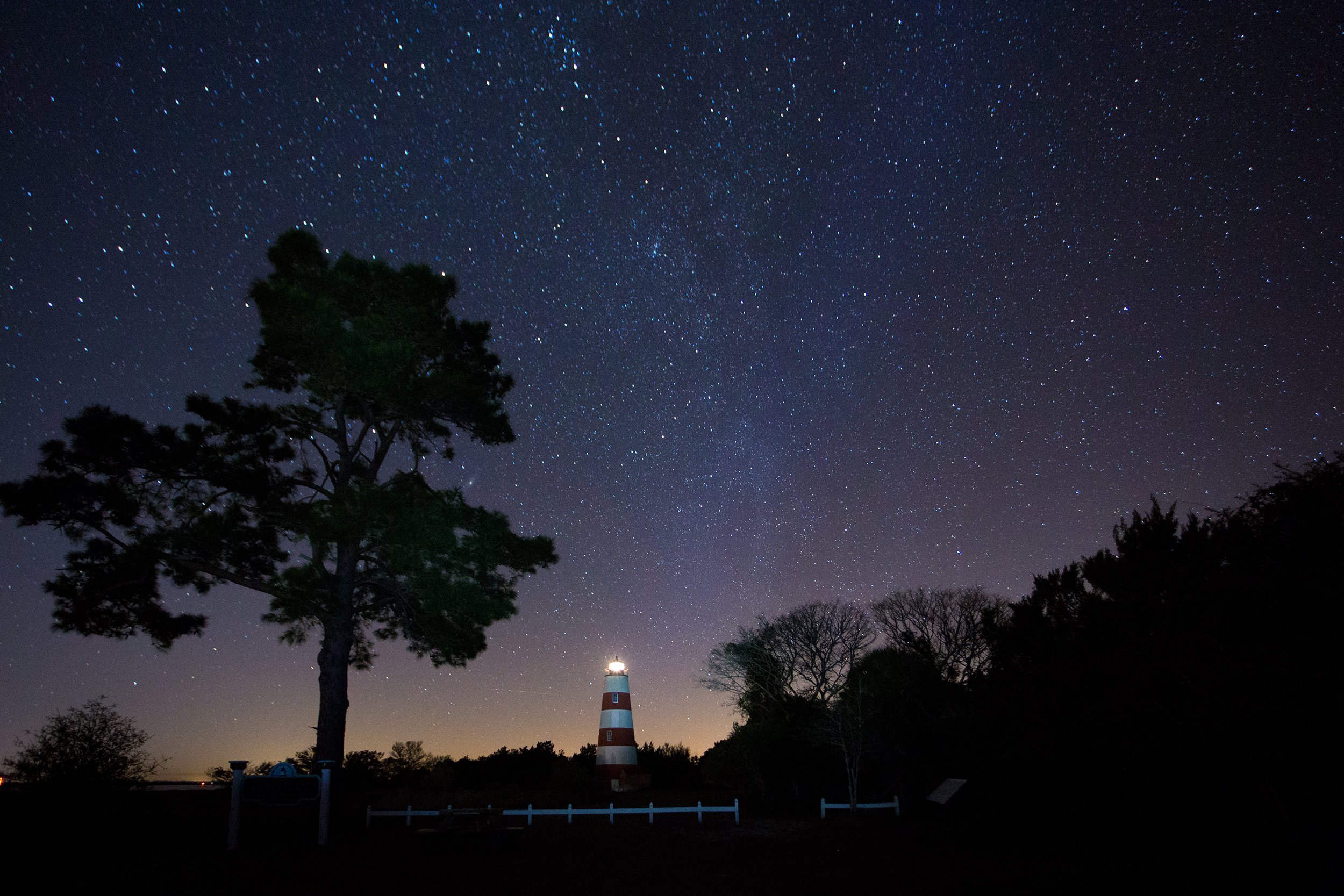Of all the remarkable places in our country, the Southeastern coast is one of our most beloved and extraordinary places. Unfortunately, it is also now one of the most at risk due to the accelerating impacts of climate change, sea level rise, intensifying storms, and flooding. These accelerating impacts gnaw at the region’s coastline, putting residents, homes, and businesses at risk as well. In partnership with the Southern Environmental Law Center, this is the first essay in a series of stories that will highlight several environmental issues facing our region. SELC, a nonprofit and nonpartisan environmental legal advocacy organization rooted in and focused on the South, is encouraging everyone to take some time to learn more about the many risks facing the region’s coastline communities, and why smart decisions are critical for the future.
Story by Boyce Upholt | Photos by Ben Galland
“When we go down to the low-tide line, we enter a world that is as old as the earth itself — the primeval meeting place of the elements of earth and water, a place of conflict and compromise and eternal change.”
— Rachel Carson, The Edge of the Sea
Long exposure of an early-morning high tide.
There are, by common presumption, two classes of people: those who prefer the beach and those who prefer the mountains. For much of my life, I counted myself among the latter. The folded-away intimacy of an alpine cabin seemed preferable to an endless display of oil-streaked bodies bathing in the sun.
These days, I prefer another way of thinking — a bit less misanthropic — that knows the mountain is inseparable from the beach. Before Rachel Carson became famous for Silent Spring (a rare book that truly changed this country), she was working as a communications officer for the U.S. Fish and Wildlife Service in the fall of 1945 when she climbed to a peak in the Appalachians to watch the annual migration of hawks. Her eye alighted on the pale limestone, which she knew had been formed at the bottom of an ancient ocean, rock made from tiny skeletons of life forms floating in the murk.
“Now I lie back with half-closed eyes and try to realize I am at the bottom of another ocean — an ocean of air on which the hawks are sailing,” Carson wrote in her field notes that day.
Carson knew her science. The success of Silent Spring has eclipsed the facts of her early literary career: Her first books, all bestsellers, were focused on the seas. It’s our collective loss that these books have been largely overlooked, as the “Sea Trilogy” ranks among the finest works of U.S. nature writing. The Edge of the Sea, the last book in the trio, published in 1955, should be required reading for anyone visiting the beach this summer.
Driftwood beach, Jekyll Island, Ga.
“Understanding comes only when, standing on a beach, we can sense the long rhythms of earth and sea that sculptured its landforms and produced the rock and sand of which it is composed,” she writes. “[E]ach grain on a beach is the result of processes that go back into the shadowy beginnings of life, or of the earth itself.”
The lure of the sea can seem universal and timeless. And this is not an entirely wrong assumption: There is substantial evidence that the first people to populate North America arrived not by marching down the middle of the continent, as I was taught in high school a few decades ago, but by passing along its coastlines. Carson called the coast a place of “conflict and compromise,” which is true, but the mingling of waters sweet and salty, of mud and sand and water and land, also creates a profusion of life. The edge of the ocean has always been among the world’s best places to eat. Indigenous cultures thrived along, and often revered, this liminal zone.
Sunrise in a forming tidal creek.
The first Europeans to arrive in North America found less to admire. One 18th-century sailor decried the “dreadful squalls” and “bleak winter winds” on Florida’s beaches. The kind of paradise we envision today has its roots in England, where in the 19th century doctors began to prescribe a quick dip into saltwater as a restorative cure for exhausted urbanites. It’s a custom that eventually spread across the pond, morphing and propagating until the beach became known as a glittering wonderland of leisure. Despite summertime magazine lists ranking the country’s best beaches, they sometimes seem interchangeable to me. “I got my toes in the water, ass in the sand,” Zac Brown sings. “Not a worry in the world, a cold beer in my hand.” An anthem that can be played in any coastal town.
But what got lost when The Beach became an obsession and a symbol synonymous with palm trees and turquoise water is that every coastline has its own biography. Carson notes, for example, that in North Carolina the amount of shell sand, made from broken bits of sea-life exoskeleton, suddenly jumps upward compared to what’s on northern beaches. Most beaches in Florida have sand made from rocks in the far-flung Appalachians that have been carried south, though in the Keys the sand is made of coral and shells. Here in Louisiana, where I live, we have few beaches that might inspire you to lay out a towel for a sunbathing nap. Our coast has been formed by Mississippi River mud. The wet soils are black and slimy, at least where they aren’t carpeted in marshes. If that sounds unappealing to you, well, I don’t mind: That will leave more quiet coastline for me to enjoy.
Though, really, that’s too blithe. The marshes that thrive here in Louisiana — and all along the Atlantic coast, in bays and other settings sheltered from waves — have a beauty that can match any sandy beach, and they need as much or more of our love.
Sunrise on a receding tide.
Pay attention and the shoreline will teach you about the world’s constant motions. Winds scatter the smallest speckles of sand, forming ever-shifting dunes; waves rip inland; new deltas are delivered by the downslope trickle of water and silt into the sea. Tomorrow’s beach will present an entirely new scene.
Expand the timeline and the changes become overwhelming. The seas along the Atlantic coast once reached the edge of the Appalachian Mountains. Later, as the world chilled, as water hardened into glaciers, sea levels dropped. Bits of rock, torn from the mountains by waves, were laid out into a long slope of sand. Similar processes beset other coastlines, though with different effects: A few years ago, a diver discovered an entire cypress forest in the water off the coast of Alabama preserved in the mud — a relic of an ancient swamp that extended miles beyond today’s shoreline. In Louisiana, meanwhile, the land is of far more recent vintage: The mud beneath me in New Orleans is little more than 4,000 years old. By way of comparison, much of the surface rock across the midwestern U.S. was formed during the Paleozoic Era, which ended hundreds of millions of years ago. The difference goes beyond orders of magnitude: If you compress all the time since the Paleozoic into a single day, New Orleans’ mud begins accumulating 10 seconds before midnight. The coastline we know today is, as Carson writes, “of little moment in the history of the earth.”
Winter nightscape of the Sapelo Island light.
There is danger in discussing deep time: It can offer an excuse. A man I recently met in Cocodrie, Louisiana — a coastal town, beyond the state’s hurricane-protection levee, that was ravaged by Hurricane Ida — after indicating how much the world has changed throughout the past, suggested the Earth is going to do what it does.
Which, I guess so. There will always be beaches; the water will find its shore. Study the deeper story of the beaches and marshes that line our coast and you’ll likely decide that you’re lucky to live in this era: The past 10,000 years or so have been a remarkably pleasant time to be a human being.
Suddenly, geological changes are happening far too fast, and it’s by our actions: Mountaintop mining is doing more to rewrite geology than the erosion caused by all the world’s rivers. Carbon is turning from geologic to atmospheric — from oil to air — at a rate not known for hundreds of thousands of years. Now the shore is not just changing but disappearing, and not only because of rising oceans. Coastal wetlands have been cleared for development — more than half of the wetlands in the Southeast have disappeared in the past 50 years — which means there is less storage for incoming tides and more flooding in land that used to stay dry. Marshes can “migrate” with the rising seas, reestablishing in the new zones of shallow water, but not when roads and seawalls and other obstructions block their path.
Beaches or mountains, it doesn’t really matter: Both are the latest chapter in the same long story. It’s by cosmic luck that we’ve wound up on a planet quite so beautiful. This weekend, whether you’re lying on white sands or tromping through marsh muck or looking down from a mountain overlook, you might consider contemplating how what you see came to be, and what you can do to keep it intact.
The Southern Environmental Law Center, a nonprofit, nonpartisan environmental legal advocacy organization rooted in and focused on the South, continues to explore how these changes are playing out in the region’s coastline communities, and why smart decisions are critical for the future.
Over the past year, SELC has worked to create a new mapping tool and website, The Changing Coast, to help communities navigate climate change by understanding the region’s changing coast.
Boyce Upholt is a freelance writer living in New Orleans. He won the 2019 James Beard Award for investigative journalism, and his work has been noted in the Best American Science and Nature Writing series. Follow Boyce's work at www.boyceupholt.com or on Instagram @boyceu.
Ben Galland is a native of St. Simons Island, Georgia. He co-founded h2o creative group, a Brunswick, Georgia, marketing agency where he is the principal photographer. Photography and the outdoors are his passions, and when not shooting commercially, he can be found in the woods or on the river with a camera.








